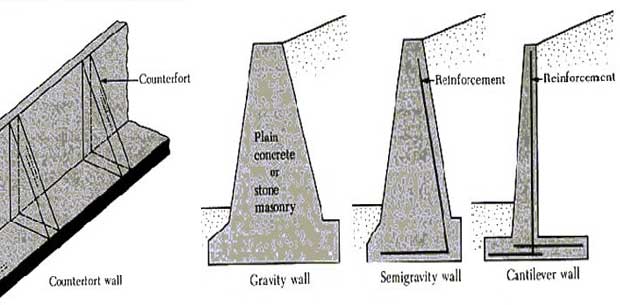Unknown Facts About Construction Company Austin
Table of ContentsWhat Does Ace Construction Company Do?Some Ideas on Ace Construction Company You Should KnowThe Only Guide to Construction Company AustinLittle Known Facts About Ace Construction Company Texas.
Given that these products can not withstand considerable stress, the design focuses on avoiding tension in the wall. Some gravity walls do not utilize mortar, relying solely on their weight to remain in location, as when it comes to dry stone walls. These walls typically are trapezoidal in area as displayed in Fig.2. Gravity walls need heavy structure due to the large size of the wall. They are economical and ideal for just small heights (construction company austin). A gravity keeping wall provided with a little quantity of reinforcement for minimizing the mass of the concrete is called semi-gravity keeping wall, as displayed in Fig.
3. The lateral earth pressure is mainly withstood by the mass of the wall, as in the case of a gravity maintaining wall. These are the enhanced concrete walls in which lateral earth pressure is withstood by structural action of its members. The base of the wall is extended into the backfill on the heel side and is referred to as heel piece, as shown in Fig.
4. The backfill over the heel slab offers substantial additional lateral stability to the wall. The back of the wall on the heel side is likewise given a slope. This increases the width of the wall with depth, comparable to the increase in lateral earth pressure with depth. The vertical wall (known as stem), the heel slab, and the toe piece function as cantilevers repaired at their junction and spanning to the other end.
The Of Construction Company Austin

The heel piece and the toe slab undergo resultant upward soil pressure from the bottom and bend up. Support is for that reason provided on the tension side, that is, vertically on the behind of the stem and horizontally at the bottom of the heel piece and the toe slab.
Cantilever maintaining walls appropriate for keeping the backfill to moderate heights of 4-7 m. In sample, most cantilevered walls appear like "L" s or inverted "T" s. Where foundation soils are bad, earth tieback keeping walls are another choice. These walls are reversed not just by a big base but also by a series of horizontal bars or strips extending out from the vertical surface into the backfill.
As soon as an earth tieback retaining wall is backfilled, the weight and friction of the fill against the horizontal members anchors the structure. When the height of a cantilever retaining wall is more than about 7 m, it is affordable to offer a vertical bracing system, understood as counterforts, on the backfill side above the heel slab.
16. 5. The stem and the heel piece function as constant slabs covering horizontally along the length of the wall between the counterforts. The use of counterforts decreases the bending minute due to earth pressure and thus the size and reinforcement of the stem and the heel piece. Counterforts go through tension due to the action of lateral earth pressure of the backfill on the stem.
All about Construction Company Austin
Figure 16. 6 reveals a strengthened keeping wall. The structural action of the stem is the same as in a counterfort keeping wall. Nevertheless, the heel slab functions as a cantilever slab as in a cantilever maintaining wall. The toe piece acts as a constant piece spanning along the length of the wall in between the buttresses.
ADS: Sheet piles are versatile retaining structures utilized to supply a momentary building area for building and construction of structures. Sheet stacks are made of wood, steel, or often strengthened concrete. Lumber sheet stacks were used in the past but their reuse is restricted for momentary structures approximately shallow depth. For all important structures and for depth > 3 m, steel sheet piles are more typically utilized.
Reinforced cement concrete (RCC) sheet piles might be often utilized in great sand or soft clays. RCC stacks might get harmed or broken under driving tensions in stiff soils. Sheet piles are installed by first driving the steel or wood sheets into the soil. The soil on the front side is then dug up (gotten rid of) out.


The smart Trick of Ace Construction Company Texas That Nobody is Discussing
For try this out this reason, the depth of foundation (embedment) is large compared with that in a maintaining wall. The thickness of sheet stacks is extremely little compared to the depth and length of a click for info wall. Hence, the weight of a sheet pile is really little and is usually disregarded in the design. ADS: The soil on the back of the sheet stack is typically eliminated and backfilled with a cohesionless soil. Ace Construction Company Texas.
However, the soil listed below the dredge level might be either a cohesionless soil or a cohesive soil, depending upon the soil profile at the site of building - Ace Construction Company Texas. Sheet piles having water on the front side utilized in dock and harbor structures to assist in berthing of vessels (ships) are referred to as bulk heads.
Standard sections of steel sheet stacks as recommended by US Steel (1984) are shown in Table 16. 3. i. Cantilever sheet stack. ii. Anchored sheet stack. The cantilever sheet stack obtains its support from the embedment into the underlying soil below Continue the dredge level, as revealed in Fig. 16. 11.
In the case of anchored sheet stacks, extra lateral assistance is offered by ways of anchor rods repaired to the sheet stack near the top and anchored appropriately, as shown in Fig. 16. 12. The lateral stability of anchored sheet piles is obtained both from the embedment into the soil below the dredge level as well as by the support supplied by the anchor or tie rod.